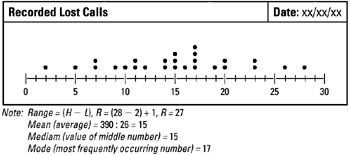Tool 69: Dot Diagram
| AKA | Dot Plot |
| Classification | Analyzing/Trending (AT) |
Tool description
A dot diagram tool allows data to be displayed for quick analysis. Observations of some sets of numbers are dotted along a scale to indicate a natural tendency to form a normal (bell-shaped) distribution, or to show clustering around a central value. It can also be used to check for patterns in recorded data.
Typical application
-
To display the relationship or distance between the numbers (observations) in a small sample or population of numbers (≤30).
-
To provide quick measurements of range and average, and to show the dispersion of data.
Problem-solving phase
| → | Select and define problem or opportunity |
| → | Identify and analyze causes or potential change |
| Develop and plan possible solutions or change | |
| Implement and evaluate solution or change | |
| Measure and report solution or change results | |
| Recognize and reward team efforts |
Typically used by
| 1 | Research/statistics |
| Creativity/innovation | |
| Engineering | |
| Project management | |
| Manufacturing | |
| Marketing/sales | |
| Administration/documentation | |
| Servicing/support | |
| 3 | Customer/quality metrics |
| Change management |
before
-
Data Collection Strategy
-
Sampling Methods
-
Observation
-
Checksheet
-
Surveying
after
-
Stem-and-Leaf Display
-
Problem Analysis
-
Monthly Assessment Schedule
-
Descriptive Statistics
-
Demographic Analysis
Notes and key points
-
A dot diagram should not be used for more than 30 observations.
-
Numbers that are off the scale should be reported as outliers.
Step-by-step proceudre
-
STEP 1 Collect and record data. Sort values (numbers) from low to high. See example Recorded Lost Calls.
-
STEP 2 Draw a horizontal line and mark or scale units of measurement, as shown in the example.
-
STEP 3 Place a dot for each value (number) and continue until all numbers have been dotted. When finished dotting, the dot diagram displays all values and how often they occurred.
-
STEP 4 If desired, basic statistical analysis can be completed as shown.
Example of tool application

EAN: 2147483647
Pages: 326